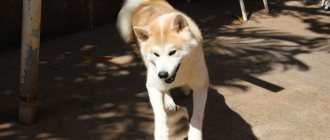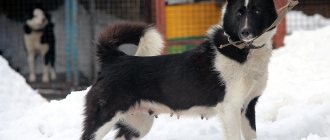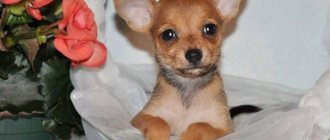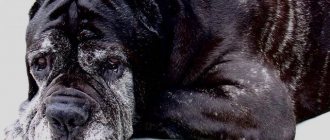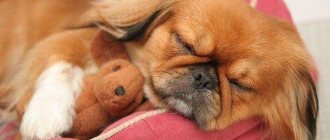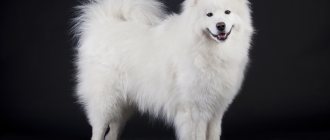History of the origin of the Shar Pei
There is an opinion that the Shar Pei first appeared in China, but this is just a hypothesis. Marco Polo, who lived in China for several years, described the Chow Chow and the Pug in 1271, but never mentioned the Shar Pei.
The most likely version of the origin of this dog breed dates back to 1751, when the Emperor of China initiated maritime trade. At that time, a popular game among English sailors was dog fighting. The British used bulldogs and mastiffs. The Chinese, not to be outdone, mixed their Chow Chows with English breeds to create a fighting dog. Despite this, the new breed still could not compete with the strong bulldogs.
Shar Peis were also widely used as hunting dogs. Hunting was a popular game among the nobility; they even started entire packs of Shar Peis, who were distinguished by their strength and intelligence.
In the 1940s, Mao Zedong called this cute breed “a symbol of the uselessness of the privileged class,” and terrible times came for Shar Peis - they began to be exterminated en masse, and exorbitant taxes were imposed on wealthy owners of purebred dogs. This led to the breed being almost completely destroyed. In 1950, only a few Shar Pei litters remained in Taiwan. Shar Peis were practically exterminated. Fighting dogs are preserved only in the capital.
After 15 years, the world recognized the Shar Pei with the nickname “Lucky”. He was born thanks to S.M. Chen. Then the dog was bought by the American breeder Herman Smith and Lucky became a pioneer - an immigrant to the United States. Another breeder, Matgo Low, saw an article in Dogs magazine about endangered breeds with a picture of a Shar Pei and the inscription “The last surviving representative of the breed”, asked all four-legged lovers to save these dogs from extinction.
From 1970 to 1975 enterprising people looked for dogs and restored the breed. Thanks to them, these dogs were able to spread throughout the world and delight us with kind smiles, soft faces and huge blue tongues.
Is a muzzle necessary?
To understand whether Shar Peis need a muzzle, you need to remember for what purposes this breed was originally used and for what purposes it is used now.
In ancient times, Shar Peis were a fighting breed of dog, but now they are excellent watchmen and security guards. That is, they may well show aggression if they feel threatened. For this reason, no matter how confident you are in your dog, it is by no means decorative, which means it will need a muzzle.
You can make a muzzle to order or buy a ready-made one in a special store.
Also, do not choose an iron one - it can be traumatic for the animal itself and for humans. It is better to opt for leather.
You need to wear a muzzle in crowded places.
Shar Pei ears should be treated at the end of each week. This should be done with a cotton pad moistened with warm water or a special solution purchased at a pet store. You should not clean with a cotton swab, because it can damage the eardrum and the delicate skin of your dog’s ears.
You must teach your Shar Pei to this procedure from childhood so that it does not break out. The Shar Pei's evasion from your hands can cause injury.
To properly clean your Shar Pei's ears, your brushing movements should be gentle, but firm and quick.
- First, find a place that is comfortable for your puppy to go to. It should be close to home;
- In order for the puppy to understand that this is exactly the place, you can put there the diaper that the dog wore at home;
- Guess what time the Shar Pei goes to the toilet and shortly before that, bring him to the designated place;
- Don't rush the puppy, let him concentrate. If the puppy managed to do the job, then praise him and take him home;
- In the future, you can gradually adjust your walking time to whatever is convenient for you.
Shar Pei Coat Types
St. Bernard and Chihuahua, Chow Chow and Weimaraner, what do these different breeds have in common? All of them have 2 types of wool in their breed - long and short. Also in the Chinese Shar-Pei , dogs have two types of coat - horse and brush.
Initially, in China, the Shar Pei had very short and coarse hair, but when restoring the breed in America, breeders used the so-called. introductory crossing, i.e. the blood of other breeds flowed in, including the closest relative of the Shar-Pei - the Chow Chow. Thus, the more familiar type of Shar-Pei with brushed hair was obtained. But Horse Shar-Peis continue to be born and are popular with some breeders and owners. But the Chinese never recognized brush dogs; for them, a Shar-Pei can still only be a horse dog.
We recommend reading: Is Feline Distemper Curable?
Horse hair is up to 1 cm long, brush hair is from 1 to 2.5 (3) cm. But often not only the length of the hair, but also the dogs themselves are very different. Brush ones look more powerful and loose, while horse ones seem slimmer and thinner. However, with the same size, the weight of a horse dog will be greater.
The folds, so beloved by many, are less noticeable on a brushed dog, because... covered with fur. And a horse dog has them all in sight. During shedding, brush coats are more troublesome than horse coats. However, the main disadvantage of horse dogs is the possible occurrence of contact dermatitis in the owner. The horse is prickly and contact with it can cause a skin reaction similar to a nettle burn - a rash and slight itching appears. But this is not a systemic disease that requires treatment, but just a skin irritation. One of our Shar-Peis has a very short horse-like coat; when he is stroked or caressed, no skin reactions occur, but if unpleasant procedures are performed on him, he is held, then he has to cover his hands with long sleeves of clothing, otherwise hives are guaranteed. But the rash goes away within a few hours, and if you wash the skin with soap, it goes away even faster. But not all Horse Shar-Peis have spiky fur! Many dogs with very short hair feel soft to the touch. For exhibitions and breeding work, this is a disadvantage, because according to the standard, the Shar Pei's coat should be hard. But for owners this is an undoubted advantage. And not all Brush Shar-Peis have nice coats! The brush should also be hard, and some brushes are so hard that they also cause skin irritation among owners. However, there are very few Shar-Pei hair
Another disadvantage of horse dogs is the inability to hide scars, bald patches, eczema, and irritation under the fur. If shedding is inaccurate, the dog will look moth-ridden; some owners even confuse shedding with skin diseases. But thorough combing, washing, and introducing vitamins into the food will help the dog shed faster and more evenly. The same recommendations apply to a brushed dog, but the appearance of the brush when shedding is usually better because... long hair covers all imperfections.
Another advantage of horse dogs can be realized during veterinary manipulations. In case of bites, injuries, minor surgical interventions, eczema, the Horse Shar-Pei's hair does not interfere, does not contaminate the wound, does not require shaving, and accordingly, after recovery, when the wound heals, the Horse Dog does not have a bald spot left from the shaved hair, and the brush will resemble owners about past troubles.
St. Bernard and Chihuahua, Chow Chow and Weimaraner, what do these different breeds have in common? All of them have 2 types of wool in their breed - long and short. Also in the Chinese Shar-Pei , dogs have two types of coat - horse and brush.
Description of the breed
Never underestimate this breed! At first glance, it may seem that Shar Peis are soft plush toys, unpretentious and gentle.
Few people know that Shar Peis were originally bred as hunting, guard and fighting dogs. This gave the breed a stubborn character and leadership position, quick reaction, intelligence and loyalty.
Definitely, Shar Peis are suitable primarily for experienced owners, people with a strong character and free time. Without early socialization and training, a Shar Pei can become aggressive and disobedient. With good training, the Shar Pei will be friendly, calm and affectionate. What your Shar Pei will be like is up to you.
Breed standard: main characteristics of Shar Pei.
Shar Peis have a recognizable “hippopotamus” face and a compact but strong body. They have average height, folds on the head and withers, small ears and a lot of charm.
Although when we think of a Shar Pei, we first of all think of a large number of folds, according to the breed standard, multiple folds on the body are undesirable. Acceptable places for folds are the cheeks, forehead, withers and base of the tail with moderate folding.
The tail is usually set very high and can take any position, but its absence is unacceptable. Of course, these rules apply only to show dogs.
The Shar Pei's coat is usually short and stiff, looking like bristles from one to two and a half centimeters. The coat color can be any color except white. Only the tail and hips can be lighter than the whole body, and the muzzle, on the contrary, is darker.
Size
Height from withers to ground - from 44 to 51 cm. Males are usually larger than females.
Shar Pei weight is from 18 to 35 kg.
Shar-Peis are a little boxy and slightly awkward in appearance, but their gait is always well-balanced.
Lifespan
Unfortunately, Shar Peis have a short lifespan of 10 years. In order for your dog to be happy and please you for a long time, you need to properly care for him and train him.
Intelligence
Shar Peis are excellent guards; their natural high intelligence and distrust allow them to accurately determine the intentions of a stranger. At the same time, he will not bark in vain and treats children well.
Despite the fact that this breed of dog is a fighting type, they will never be the first to get into a fight unless absolutely necessary.
Shar Pei character
Shar Peis have a personality that matches their appearance. These are strong, good-natured dogs who, if necessary, can both protect their owner and play with him.
- Good disposition . Here you need to remember that sharpeis, if not properly raised, can show aggression due to their origin and independent nature, so it is necessary to teach the dog good manners from an early age. In order for these dogs to be patient with children and other animals, they must be raised properly. The Shar Pei can also get along with other four-legged members of the household, be it a cat or another dog, if they were raised together.
- Attachment to the owner . Shar Peis are very attached to their owner, but this love must be earned. You should be confident, feel like the king of the situation and be the leader in your relationship with this breed. Otherwise, the Shar Pei will not obey you, and you will lose control, and your pet as well.
- Cleanliness. The cleanliness of Shar Peis is legendary. In front of a puddle, a Shar Pei will definitely stop and look at its owner: “Either go around, or go home.”
- Communication skills. Shar Pei easily make contact with early socialization.
- Energy. Dogs of this breed are very active and need frequent walks and games.
- Sharp vision. Despite the many folds on their faces, Shar Peis are very curious and notice a lot. Thanks to their good attention and keen eyesight, they can be excellent guards.
Caring for your four-legged friend
There is nothing difficult about caring for this breed. The pet needs periodic combing: this procedure improves blood flow and gets rid of dead hair.
But the ears deserve special attention. The Shar Pei's auditory canal is very thin. While swimming, you need to make sure that no water gets in there, as it contributes to the development of pathogenic microflora and various diseases.
Pets should be bathed once a month, using a rubber brush; with its help, the process of replacing fur will speed up. Since dogs' skin is very sensitive, it is recommended to use only specialized products. Each fold should be washed gently but thoroughly, then dry the animal with a hairdryer. This will reduce the risk of skin irritation.
Shar Pei training and education
Training a Shar Pei is an integral part of a dog’s growing up and upbringing. If you don't want the dog:
- showed aggression towards passers-by;
- barked at dogs and children;
- picked up food from the floor;
- walked you, not you him;
- spoiled your things;
- did not respond to his name and did any uncontrollable things, then training a Shar Pei needs to be taken more than seriously!
Shar Peis learn very quickly, and if you have the patience to repeat the same exercises over and over again, the results will not be long in coming. Already at three to four months you can begin a general course of dog training.
Training a Shar Pei is not much different from training other breeds. The main thing here is to follow the general rules and do everything in moderation.
The main thing to remember:
- Proper puppy training will avoid many problems in the future. The rule “Hard to learn, easy to fight” applies here.
- Shar Peis enjoy training because they feel important and needed, and are always looking forward to their next lesson.
- Your Shar Pei will not love you less from daily training; on the contrary, you will develop close contact with your pet.
- If the dog does something wrong, then most likely you are doing something wrong. Never accuse her of lack of understanding, do not scold her, and do not beat her under any circumstances.
All dogs have a general set of training rules. When training with a Shar Pei, in addition to these rules, you need to remember the character of the individual breed and take into account the disposition of your dog.
Rules for keeping and caring for Shar Pei
Healthy Shar-Peis do not require painstaking care; a set of minimum rules is enough:
- Wool. Regular brushing to remove dead hair. Once a week.
- Washing the dog. Like any other breed of dog, the Shar Pei does not need to be bathed often, once a month is enough. This does not apply to washing paws and belly after walks. A breed characteristic of the Shar Pei is its folds, which must be thoroughly dried after bathing to prevent diaper rash. It is worth remembering that frequent bathing can lead to a protective reaction of the skin - excessive secretion of sebum will begin, and this will lead to flaking and dandruff. You can wash your Shar Pei's head, but it is recommended to plug your ears with a cotton pad. For bathing, you should use a rubber brush and special shampoos for dogs. It is important to take into account that Shar Peis are ardent opponents of water and will resist bathing, so they need to be taught to wash from childhood. After swimming, you can go for a walk 3 hours later.
- Drying. After bathing, the Shar Pei must be thoroughly dried with a hairdryer, paying special attention to the folds. To remove all excess moisture, you can use dog powder or baby powder.
- The ears are poorly ventilated, so they need to be examined a couple of times a week. If your Shar Pei frequently scratches its ear or shakes its head, you should visit a veterinarian as it may be due to an ear infection. It is not recommended to clean the ear canals with cotton swabs (to avoid intensifying the inflammatory process, if present).
- Walking. Shar Peis require vigorous exercise, so be prepared to walk them at least twice a day for long periods of time. Remember that this will make them calmer and happier. Try to limit your dog's exposure to the street in hot weather, as his head is sensitive to high temperatures. Shar-Peis do best in temperate climates. It is recommended to feed dogs after a walk (a 15-minute break is enough).
- Shedding. Shar Peis shed once or twice a year. During this period, you need to help the skin get rid of dead hair using a rubber mitt or brush.
- nails should be trimmed on average once a month using a nail clipper. It's all individual. An animal that has a good load, lives in the city and, with constant contact with a hard surface, for example, asphalt, needs claw trimming more rarely than their counterparts living outside the city, on the grass. For a Shar Pei, this procedure is very unpleasant, so be gentle, but persistent, and do not shout at all. If the dog completely refuses to give his paw, you can trim one nail, give him a treat, and trim the other the next day. The normal position of a Shar Pei's claws when standing is in line with the base of the paw.
- Paw pads. Keep an eye on the paw pads - never ignore even the smallest cracks. They can cause discomfort and spoil the mood of both the dog and you. Rub urea cream into the skin of your paws.
- The eyes also need regular examination. Normal condition - no souring or redness. In the morning, the eyes may become slightly sour - this is normal; the eyes should be lightly wiped with a gauze cloth. If your Shar Pei's eyes are red, the eyelids are swollen, or a crust has formed, go to the vet immediately.
- Teeth. Check your pet's bite regularly, starting at three months of age. Do not allow the development of a “tight lip” - a turning inward. When your Shar Pei's teeth change, he will want to chew everything indiscriminately, so buy your pet a hard rubber toy or a rope toy for cleaning his teeth, and do not forget to change it.
- Parasites. To prevent ticks and fleas, spray your Shar Pei with a special anti-parasite product. At least 1 time per month. Do not overdo it, read the instructions carefully and use the drug according to weight.
After forest walks, always inspect your pet's skin.
If your Shar Pei does not want to eat or drink, has become lethargic, the body temperature has risen above 39 degrees, the color of the urine has changed and become darker, go to the veterinarian. Perhaps the dog was bitten by a tick or became a victim of another ectoparasite.
In addition to ectoparasites, there are endoparasites that live in the internal organs of animals (helminths). Medicines for this scourge should be taken regularly.
Rules of care
Let's learn how to properly care for a Shar Pei at home.
For fur and leather
In normal times, your Shar Pei should be brushed every 2-3 days with a short-toothed massage brush.
Similar article: History of origin and description of the Shar Pei breed
When a Shar Pei sheds, bald spots appear on it. During the shedding period, brushing should be done daily. On average, molting lasts 2–3 weeks. The process can be speeded up by plucking the fur by hand.
You need to bathe your dog about once a month with specialized shampoos. Rinse the folds thoroughly so that no shampoo remains on them. After bathing, dry your dog thoroughly (you can use a hairdryer) and treat the folds with baby powder.
Attention, Shar Peis should not get their hair wet, and their ears must be plugged with cotton swabs in advance!
Ears
Due to their small size and thin ear canals, Shar Pei ears are poorly ventilated, which can lead to infections. They need to be checked at least 1-2 times a week. If your pet begins to shake its head frequently and scratch its ear, take it to the vet. Water should never get into the ears, as this causes otitis media.
With your eyes
Check your eyes regularly. Remove morning sourness with a soft cloth (not lint). If they start to water, take your dog to the vet immediately.
With teeth
Caring for your Shar Pei should include regular teeth brushing due to its predisposition to tartar. Also buy chewing toys for your dog. During the teething period, puppies are given “bones” made from ox veins, toys made from ropes and hard rubber. You can give your baby dried beef ear or tail.
We recommend this article:
How to choose and name a Shar Pei puppy beautifully
What to feed Shar-Peis?
Proper nutrition is an important component of health and good mood. You can go two ways - choose ready-made dry food or natural food.
The main thing is not to mix. Decide: either natural feeding or industrial dry (wet) food from one company.
Never skimp on your dog! If you cannot provide your pet with quality food, it is better not to get one.
When feeding dry food:
- Follow the instructions on the food box.
- Keep an eye on the expiration date.
- Carefully switch to a new product, in small portions, preferably within a week.
When feeding natural food:
- Fresh food at room temperature.
- Teach your Shar Pei puppy to eat from a stand, and only from a bowl. Subsequently, this will protect him from poisoning on the street.
- If your pet is underfed, put the food in the refrigerator, and next time reduce the portion;
- After eating, wipe any remaining food from the face with a damp cloth, paying special attention to the lips and dewlap.
Forbidden:
- Smoked products
- Pasta
- Sweets
- Chocolate
- Bird with small tubular bones
- Fatty pork
- Legumes
- Cabbage
- Potato
- Eggs
- Hard cheese
Healthy:
- Rice
- Buckwheat
- Lean beef, if it does not cause allergies
- Mutton
- Rabbit meat
- By-products (no more than 40% of the daily meat allowance)
- Poultry meat
- Sea fish, but with great care
At one meal, you can give cereal with raw or boiled meat, taking into account the meat norm - 15 grams. by 1 kg per day. The broth from the broth is harmful to Shar Pei.
You can add zucchini, pumpkin, cauliflower or broccoli to the porridge.
Grated raw vegetables can be given with the addition of vegetable oil.
Vegetable oil is very useful for Shar Pei; in winter it can be added to any dishes, one teaspoon at a time. This will make the coat shiny and prevent cracks in the paw pads.
Please note that no owner will be able to correctly calculate the content of nutrients, microelements and other things. Therefore, when it comes to natural nutrition, it is necessary to include complex vitamins in the diet. Take in courses according to the instructions.
It is not recommended to give Shar Pei, as he is allergic, a variety of dried bones, dried tails and ears. They lead to eye skin problems.
How to feed?
An adult dog of this breed is fed twice a day, and the amount of food is calculated based on the dog’s weight - a certain proportion is maintained.
What to feed the dog - natural food or artificial food - is the choice of only the owner. Any food will be appropriate if you take proper care of the quality of the product.
If you choose industrial food for feeding your Shar Pei, then buy only those that are at least premium class. You must be sure that what is inside the package is actually meat and not substitutes or cheap offal. Therefore, read the ingredients carefully. Also, the feed must contain at least 12% fat and 23% protein.
If your choice fell on natural nutrition, then you should know that creating a proper and balanced diet is a lot of work, so it’s not the first time it’s better to contact a veterinarian for help.
The Shar Pei menu should include:
- Lean meat and offal, which should make up at least 30% of the total diet - turkey, beef, chicken, rabbit;
- Boiled sea fish;
- Fermented milk products and eggs, if you are not allergic to them;
- Porridge – buckwheat, rice, oatmeal, millet, barley, pearl barley;
- Oil (olive, vegetable);
- Fruits and vegetables;
- Vitamins.
We recommend reading: How to increase the appetite of a broulter
The food in the bowl, like the water, should be at room temperature and fresh. You cannot feed your dog from your table, as this will lead to health problems.
Prohibited for Shar-Pei are sausages, smoked and baked goods, river fish, fatty, spicy, salty foods, spices, sugar and spices, lamb, pork and bones, which Shar-Pei are not allowed to eat at any age.
Shar Pei diseases
- Allergy. A Shar Pei can be allergic for many reasons: to insect bites, food (food) and even grass (contact). Unvaccinated animals are easily susceptible to airborne viruses. It is very important to vaccinate dogs on time.
- Gastric volvulus. This can happen from the stomach filling with gas, inverting and cutting off the blood supply. In this situation, only surgical intervention can save the Shar Pei.
- Cutaneous mucinosis. Mucin is a special substance that is found on the skin of the Shar Pei. It promotes the formation of folds and wrinkles. The substance is transparent, viscous and can heal wounds. Sometimes the mucin becomes excessive and blisters appear on the skin, which burst and release fluid.
- Vomit. The cause of vomiting can most often be poisoning or, less commonly, a hernia of the esophagus and/or diaphragm.
- hernia occurs due to a weak muscular wall of the esophagus. You can get rid of a puppy’s minor illness through the correct method of feeding - the bowl should be on a stand. The puppy should be in this position when digesting food.
- Hip dysplasia. It is expressed both in tolerable pain and in agony, in which the dog requires surgical intervention. When choosing a puppy, ask for tests for diseases to which the breed is predisposed - this disease can be passed on from generation to generation.
- Weakness of the carpal ligament. Puppies with developing ligaments may be unsteady and lean forward. If you notice symptoms, contact an orthopedic surgeon. Make sure your puppy walks on a stable, non-slip surface.
- Malocclusion and tight lip syndrome. As a rule, these diseases are interrelated. If the front teeth are positioned incorrectly, the Shar Pei may develop an overshot, or more often, an undershot. Excess skin on the lower lip can cover the teeth, making it difficult for your dog to chew.
- Oily seborrhea. One of the types of skin diseases caused by increased sebum secretion and the appearance of an unpleasant odor. Most often this disease is congenital.
- Demodectic scabies (demodectic mange). The carrier of the disease is the Demodex canis tick. If you notice that your dog is itching or the skin is turning red, you need to go to the vet. He will first take a scraping, and then, after making sure, he will prescribe treatment.
- Hereditary fever, or swollen hock syndrome. A sign of hereditary fever is episodic fever - a Shar Pei can have a temperature of up to 41.7C. Most often, dogs under one and a half years old are susceptible to fever. Without treatment, the attack can last from 24 to 36 hours. Dogs suffering from this severe disease may die from concomitant amyloidosis. Symptoms : Shar Pei moves reluctantly;
- The dog's face becomes swollen and looks painful;
- There is vomiting, diarrhea, or difficulty breathing.
- weight gain;
Prevention of all problems is your love and attention to your pet. If you regularly examine your dog, monitor his behavior and well-being, and also perform routine examinations at the veterinarian, then your dog will be healthy and happy.
Shedding in dogs is a natural process.
Wool protects the dog from ticks, fleas and other parasites, infections and bad weather. But it also brings humans and animals closer together. Any dog is blissful when his coat is stroked, and the owner is always proud of his stately and representative pet.
We recommend reading: Stages of Heat in Dogs
However, there is one “but” in this ideal relationship: pets periodically renew their coats, getting rid of old hair. And then their owners puzzle over how to deal with the ubiquitous fur...
Puppies
Shar Pei puppies open their eyes at 1.5 - 2 weeks. On the 21st day, be sure to call the veterinarian to have the eyelids stapled or sewn on. The puppy will not experience severe pain, and there will be no scars on the skin. This procedure is necessary to avoid many eye diseases.
Until the 3rd week, puppies do not require special care, the main thing is to ensure that they receive enough food from their mother. Sometimes the puppy may be far from its mother and get to the milk without help. If it is the first litter, the mother may not understand why the puppy is whining.
Puppies should be kept in an absorbent diaper and changed regularly.
The first feeding of puppies is at the beginning of the 4th week. It is best to soak puppy granules in kefir and place them in the puppies' mouths. Within a week they will be able to eat from a saucer on their own.
On the 30th day of life, puppies can be given solid food.
Until 2 months after the birth of Shar Pei puppies, it is better not to separate the puppies from their mother.
If you decide to buy a Shar Pei puppy, remember 4 things:
- Comfort. If you adopted a puppy who was abandoned by its owners, get ready, it will be a difficult path through thorns to the stars. Surround your baby with comfort and all the conditions so that he can get used to you. If you purchased a Shar Pei from a nursery that has a good reputation, you don’t have to worry - the pet will be easy to contact.
- Care. A dog is a small child that requires a lot of attention and care.
- Love. Remember the popular wisdom “Treat others the way you want to be treated”? This rule also applies to dogs.
- Patience. Shar Peis can be aggressive by nature, so in order to suppress this inconvenient quality, the dog must be painstakingly trained. If you decide to buy a puppy, be prepared to be restrained and strong.
Choosing a puppy
Price for a Shar Pei puppy in Russia: 12,000 - 20,000 rubles.
Price for a Shar Pei puppy in Moscow: 15,000 - 25,000 rubles.
If you want to purchase a show-class Shar Pei, then only an experienced breeder can help. The merits of the parents are not always an indicator of the success of the puppy.
If you do not plan to participate in exhibitions and competitions, then choosing a healthy Shar Pei puppy is not difficult at all.
The puppy must be two months old and have:
- Clean ears;
- Open eyes;
- Shiny wool;
- Active behavior:
- Well-fed appearance;
- Large square head;
- Wide muzzle;
- Ears pressed tightly to the skull;
- Compact body;
- High set tail;
- Wool up to two and a half centimeters and even color;
- Blue tongue and gums. Pink spots on the tongue are allowed.
He should not have lameness, defects of the jaw, paws, or ears. There should be no soft spherical growth on the tummy (umbilical hernia).
After a thorough examination with your mind, you can begin to choose with your heart. Look carefully at each puppy and listen to yourself - with this wonderful creature you will become one and give each other many pleasant moments.
Shar Pei's first vaccinations: dog vaccination
At the time of purchasing a puppy, it is recommended to obtain from the breeder as much information as possible about the physical health of the four-legged friend, about what vaccinations the young dog has received. As a rule, the first vaccination is carried out at 2 months of age, when breastfeeding ends. After 3-4 weeks, re-vaccination follows. The final stage will be vaccination of a one-year-old dog. An adult is vaccinated annually throughout his life. When vaccinating, a standard set of vaccines is used to protect the animal from the following diseases:
- parvovirus;
- hepatitis;
- enteritis;
- leptospirosis;
- plague;
- rabies.
The vaccination schedule can be drawn up at the first visit to the veterinarian, during the examination of the puppy. Before each vaccination, the animal must undergo deworming. The animal is quarantined until the end of the first vaccination cycle. During this period, walking and prolonged stay on the street are not recommended.
